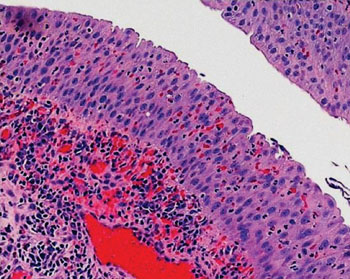Molecular Basis of Acute Cystitis Reveals Susceptibility Genes
By LabMedica International staff writers
Posted on 27 Oct 2016
Tissue damage is usually regarded as a necessary price to pay for successful elimination of pathogens by the innate immune defense, yet, it is possible to distinguish protective from destructive effects of innate immune activation and selectively attenuate molecular nodes that create pathology.Posted on 27 Oct 2016
Acute cystitis is rapidly becoming a therapeutic enigma, as antibiotic resistance is reducing the options to a minimum. The urinary bladder mucosa is often exposed to bacteria but does not always retaliate with full force. In patients with acute cystitis, infection triggers a rapid and potent innate immune and inflammatory response in the bladder mucosa and clinical symptoms include pain, urgency and frequency of urination.

Image: A histopathology of acute cystitis of the bladder (Photo courtesy of the University of Maryland School of Medicine).
Scientists at Lund University (Sweden) obtained urine samples from patients with sporadic acute cystitis at two primary care clinics. A diagnosis of acute cystitis was based on a urine dipstick analysis positive for bacteria and symptoms from the lower urinary tract, including frequency, dysuria and suprapubic pain. Midstream urine specimens were obtained at the time of diagnosis. Cystitis (CY) and asymptomatic bacteriuria (ABU) strains were prospectively isolated during a study of childhood urinary tract infection (UTI) using standard microbiological techniques. The strain collection was characterized with fimbrial genotype and phenotype, virulence factor expression, OKH antigen profiles and multilocus enzyme typing.
The team used many different techniques including a murine model, cell viability assays, cytokine measurements using DuoSet enzyme-linked immunosorbent assay (ELISA) kits and urine matrix metalloproteinase-7 (MMP-7) levels were quantified with Human total MMP-7 Immunoassay Quantikine ELISA (R&D Systems, Minneapolis, MN, USA). Other techniques employed were Western Blotting, co-immunoprecipitation, global gene expression, amongst others. Confocal microscopy was carried out using a laser-scanning LSM510 META confocal microscope (Carl Zeiss, Oberkochen, Germany).
The investigators identified acute cystitis as an Interleukin-1 beta (IL-1β)-driven, hyper-inflammatory condition of the infected urinary bladder and IL-1 receptor blockade as a novel therapeutic strategy. Disease severity was controlled by the mechanism of IL-1β processing and mice with intact inflammasome function developed a moderate, self-limiting form of cystitis. Elevated levels of IL-1β and MMP-7 were detected in patients with acute cystitis, suggesting a potential role as biomarkers and immunotherapeutic targets.
The authors concluded that that acute cystitis is amenable to IL-1 receptor inhibition and/or MMP blockade. As IL-1RA is in clinical use, short-term immunotherapy might be a realistic option as an adjunct to antibiotics in acute cystitis patients. The identified molecular disease determinants may also be helpful to address the unmet need for diagnostic tools in this patient group. The frequency of genetic variants, such as ASC mutations, and their relevance to disease would be an interesting focus of prospective clinical studies. The study was published on October 12, 2016, in the journal Public Library of Science Pathogens.
Related Links:
Lund University
R&D Systems
Carl Zeiss














